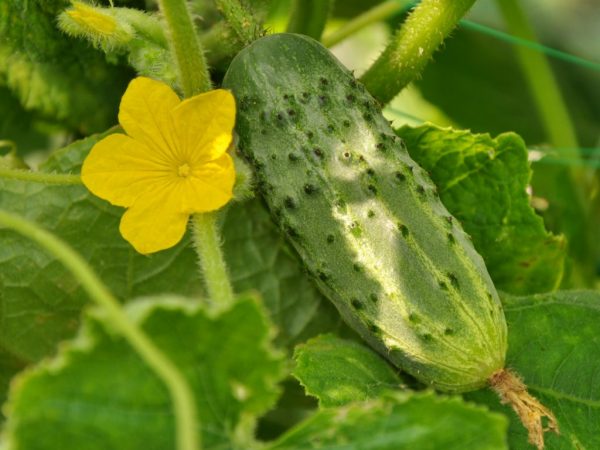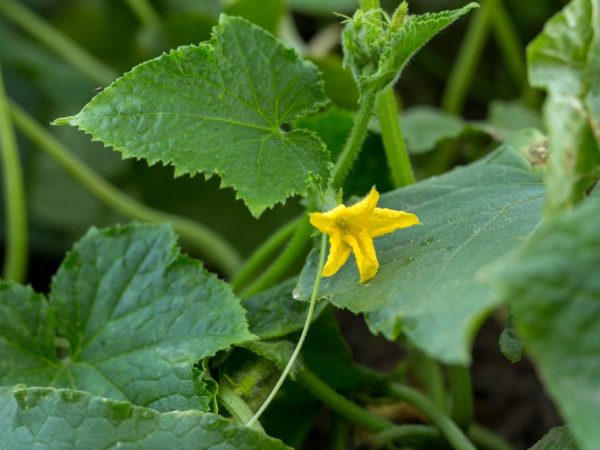Characteristics of Octopus cucumbers
Novice summer residents and even professionals in each new season are looking for new varieties of vegetable crops that can satisfy all requirements. The assortment of cucumbers of modern selection is huge, which complicates the selection process. Agronomists who specialize in the cultivation of this crop advise paying attention to the Octopus cucumber variety and its characteristics.

Characteristics of Octopus cucumbers
Characteristics of the variety
Octopus f1 is a bee-pollinated variety of Dutch selection. Produced by the Dutch company Sengenta. Which has established itself as a reliable producer of quality seed material.
The variety has a mid-early ripening period. The crop can be harvested in 43-48 days. Has a long fruiting period, which ensures high yields. 50-65 tons of cucumbers ripen on one hectare. Suitable for growing in open ground and greenhouses. The variety is resistant to high temperatures and drought, which allows it to be grown in all regions of the middle zone. Used for industrial cultivation.
A universal octopus, suitable for fresh and canned consumption. Has high taste characteristics.
Description of the bush
The bush is medium-sized with well-developed central and lateral stems. The leaves are round-pentagonal, large and medium in size, the edges are clear, slightly dissected. The color of the leaf plate is green with a clear vein pattern. 3-4 fruits are formed in the internode.
Description of the fetus
Small-sized gherkin-type fruits. The cucumber grows up to 8 cm long with an average weight of 50-70 grams. The aspect ratio of length to width is 3: 1. They have a neat shape and high-quality presentation.
Fetal characteristics:
- dense green skin;
- smooth cylindrical shape;
- the tuberosity is large;
- there are no thorns;
- the ribbing of the surface is traced;
- the pulp is dense, crispy;
- the seed box is small, the seeds are small.
Cucumbers of this variety are ideal for supplying fresh produce to the market. The harvested fruits are well stored at a temperature of 3-8 ° С
Care
Sowing seeds
For this variety, nutrient soils with a pH level of 5.5-7 are suitable. The bed for planting Octopus must be well loosened and carefully prepared.
Sow seeds for seedlings or directly into the ground. Sowing for seedlings is carried out starting from mid-April and at the age of 25-30 the seedlings are transplanted into a greenhouse or open ground. The optimal time for planting is mid-May, when the soil temperature reaches 15 ° C, and night frosts will no longer threaten young plants.
At the same time, tomatoes are sown in a seedless way directly into the ground. It must be remembered that cucumber seeds do not germinate at temperatures below 12 ° C and may die. Adequate space should be left between the plants, given the vigor of the bushes. The optimal would be 30-40 cm between seedlings and from 60 cm there should be a width between rows.Thickening should not be more than 3 plants per 1 sq. M.
Top dressing

The plant needs fertilization
To ensure full growth, development and fruiting, cucumbers will need fertilizing.
During the growing season, it is enough to carry out it three times.
- 2 weeks after planting in the ground or germination. They use a complex fertilizer for pumpkin seeds. Soluble balanced fertilizers (Master, Kemira, Viva) are suitable. Apply the instructions accordingly.
- At the beginning of flowering, the bushes are sprayed with a solution of carbamide (5 g per 10 l of water), and a week later with a preparation to stimulate the ovary (Ovary, Phytocarpine, Boroplus).
- 14 days after the previous one, spray with urea, or complex chelated fertilizer (Plantafol, Clean sheet).
Watering
In order for the bushes to grow well, the fruits are tied, and the harvest reaches maximum levels, watering must be regular and correct.
On hot days, the bushes are watered twice a day. The best time to water is morning and evening. Spraying with clean water also has a beneficial effect on plants.
Reduce watering on cooler days. An excess of moisture has a bad effect on the growth of cucumbers and leads to the development of fungal diseases. And also it is impossible to water with cold water, for cucumbers this is unacceptable.
Pests and diseases
The Octopus variety, in accordance with the description, is resistant to the following diseases:
- powdery mildew;
- cladosporosis;
- cucumber mosaic.
Requires preventive treatments for fusarium and paresporosis. To protect against these diseases, the bushes are sprayed with Trichodermin, Fitosporin or other biofungicides and enzymes every 10 days. They are environmentally friendly and protect the bushes well from fungal diseases.
Plants may be damaged by pests, especially if the summers are hot and dry. Aphids and spider mites can be found on the bushes. These are parasitic pests that drain cucumbers and can prevent them from developing at full strength. For pest control, it is advisable to use industrial insecticides, bioinsecticides, and folk recipes have proven themselves well.
What to process
Recommended preparations for the treatment of pests from cucumbers:
- Insecticides: Mospilan, Aktelik.
- Bioinsecticides: Bioreid, Aktofit.
- Folk remedies: onion peel, garlic peel, tobacco dust, ash.
All these funds show their effectiveness in the fight against garden pests on cucumbers and can easily cope with them.
Conclusion
By choosing Octopus f1 for growing in a greenhouse or open field, you can get a good harvest for a long time from a small garden bed. And the taste of fresh self-grown cucumbers will delight even the most fastidious gourmet.
This variety will not disappoint with its characteristics and gardening professionals who have practice in growing a variety of cucumbers for industrial purposes.


